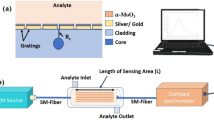Abstract
We propose a surface plasmon resonance (SPR)-based refractive index sensor using gold-alumina grating over aluminum film for biosensing. Conventional SPR sensor based on gold grating exhibits broader SPR dips whereas that based on aluminum grating exhibits narrow reflection dip. A narrow reflection dip is desirable as it provides good resolution and improves the accuracy of measurement. Aluminum is less stable and generally is not preferred for an SPR-based sensor. It is more prone to being oxidized, which reduces the sensitivity and increases the width of the reflection dip of the sensor. While gold cannot provide narrow SPR reflection dips, but is used as an SPR active metal due to its more chemical stability. In order to improve the accuracy of gold grating-based sensor while taking care of oxidation problem of aluminum, in this paper, we propose a gold grating over aluminum film for SPR-based sensor and show that this configuration improves the sensitivity and the detection accuracy of the conventional sensor. Moreover, the oxidation problem is reduced to some extent as a part of aluminum is covered with gold. In order to completely avoid the oxidation of aluminum, we further propose to cover the exposed part of the aluminum with alumina and show that this configuration further improves the accuracy by reducing the width of the SPR reflection dip without affecting the sensitivity significantly. Numerical simulations show that sensitivity of proposed sensor is 270.33°/RIU with quality factor of more than 267.65 RIU−1.








Similar content being viewed by others
References
Maier SA (2007) Plasmonics: fundamentals and applications. Springer, New York
Liedberg B, Nylander C, Lundstrom I (1983) Surface plasmons resonance for gas detection and biosensing. Sens. Actuators 4:299–304
Kretschmann E, Raether H (1968) Radiative decay of nonradiative surface plasmons excited by light. Z Naturforsch 23:2135–2136
Fano U (1941) The theory of anomalous diffraction gratings and of quasi-stationary waves on metallic surfaces (Sommerfeld’s waves). J Opt Soc Am 31:213–222
Hutley MC, Maystre D (1976) The total absorption of light by a diffraction grating. Opt Commun 19:431–436
Homola J, Yee SS, Gauglitz G (1999) Surface plasmon resonance sensors: review. Sens Actuators B: Chem 54:3–15
Roh S, Chung T, Lee B (2011) Overview of the characteristics of micro- and nano-structured surface plasmon resonance sensors. Sensors 11:1565–1588
Takeuchi H, Thongborisute J, Matsui Y, Sugihara H, Yamamoto H, Kawashima Y (2005) Novel mucoadhesion tests for polymers and polymer-coated particles to design optimal mucoadhesive drug delivery systems. Adv Drug Deliv Rev 57:1583–1594
Pyayt AL, Wiley B, Xia Y, Chen A, Dalton L (2008) Integration of photonic and silver nanowire plasmonic waveguides. Nature nanotech 3:660–665
Guo J, Keathley PD, Hastings JT (2008) Dual-mode surface-plasmon-resonance sensors using angular interrogation. Opt Lett 33:512–514
Byun KM, Kim SJ, Kim D (2007) Grating-coupled transmission-type surface plasmon resonance sensors based on dielectric and metallic gratings. Appl Opt 46:5703–5708
Lin K, Lu Y, Chen J, Zheng R, Wang P, Ming H (2008) Surface plasmon resonance hydrogen sensor based on metallic grating with high sensitivity. Opt Express 16:18599–18604
Wu F, Liu L, Feng L, Xu D, Lu N (2015) Improving the sensing performance of double gold gratings by oblique incident light. Nano 7:13026–13032
Dhibi A, Khemiri M, Oumezzine M (2016) Theoretical study of surface plasmon resonance sensors based on 2D bimetallic alloy grating. Phot Nano Fund Appl 22:1–8
Cai D, Lu Y, Lin K, Wang P, Ming H (2008) Improving sensitivity of SPR sensor based on grating by double-dips method (DDM). Opt Express 16:14597–14602
Sharma AK, Gupta BD (2007) On the performance of different bimetallic combinations in surface plasmon resonance based fiber optic sensors. J Appl Phys 101:093111–0931116
Jha R, Sharma AK (2009) High-performance sensor based on surface plasmon resonance with chalcogenide prism and aluminum for detection in infrared. Opt Lett 34:749–751
Hu C, Liu D (2010) High-performance grating coupled surface plasmon resonance sensor based on Al-Au bimetallic layer. Mod Appl Sci 4:8–13
Su W, Zheng G, Li X (2012) Design of a highly sensitive surface plasmon resonance sensor using aluminum-based diffraction grating. Opt Commun 285:4603–4607
Bijalwan A, Rastogi V (2017) Sensitivity enhancement of a conventional gold grating assisted surface plasmon resonance sensor by using a bimetallic configuration. Appl Opt 56:9606–9612
Moharam MG, Grann EB, Pommet DA, Gaylord TK (1995) Formulation for stable and efficient implementation of the rigorous coupled-wave analysis of binary gratings. J Opt Soc Am A 12:1068–1076
Lee W, Degertekin FL (2004) Rigorous coupled-wave analysis of multilayered grating structures. J Lightwave Technol 22:2359–2363
Yuk JS, Guignon EF, Lynes MA (2014) Sensitivity enhancement of a grating-based surface plasmon-coupled emission (SPCE) biosensor chip using gold thickness. Chem Phys Lett 591:5–9
Hass G (1949) On the preparation of hard oxide films with precisely controlled thickness on evaporated aluminum mirrors. J Opt Soc Am 39:532–540
Author information
Authors and Affiliations
Corresponding author
Rights and permissions
About this article
Cite this article
Bijalwan, A., Rastogi, V. Design Analysis of Refractive Index Sensor with High Quality Factor Using Au-Al2O3 Grating on Aluminum. Plasmonics 13, 1995–2000 (2018). https://doi.org/10.1007/s11468-018-0715-5
Received:
Accepted:
Published:
Issue Date:
DOI: https://doi.org/10.1007/s11468-018-0715-5




